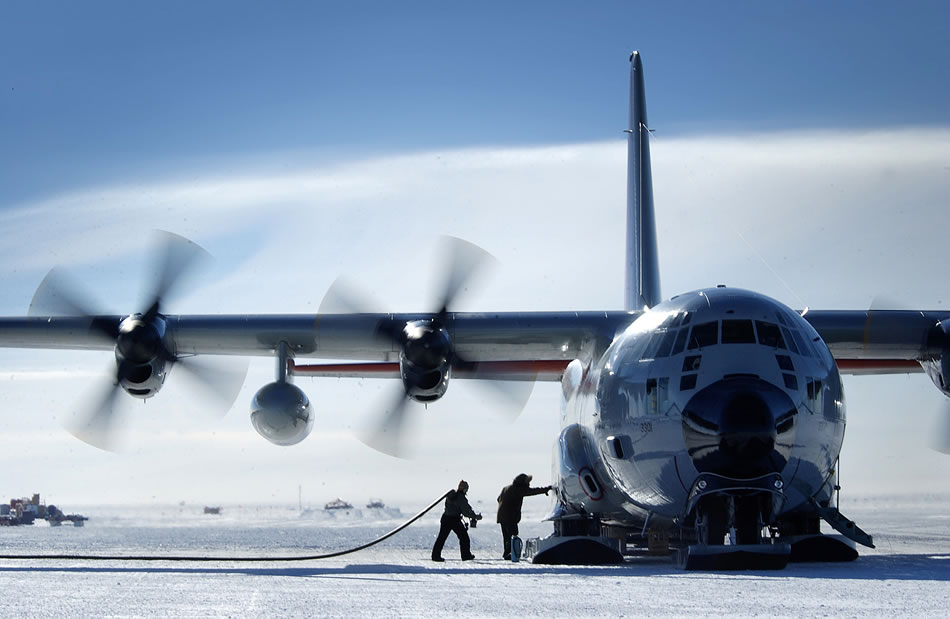
Posted: 02/01/2005
ADMUNSEN-SCOTT SOUTH POLE STATION, Antarctica -- An Air National Guard LC-130H Hercules sits while crews unload fuel and cargo here during a recent mission. The LC-130H is equipped with ski-landing gear that allows the aircraft to land on ice or snow while airlifting supplies to remote locations throughout the Antarctic continent. (U.S. Air Force photo by Master Sgt. Efrain Gonzalez)
Operation Deep Freeze sees end of C-141 Starlifter era
by Master Sgt. Chuck Roberts
Air Force Print News 1/31/2005 - CHRISTCHURCH, New Zealand -- Thegateway to the highest, driest and coldest continent on earth remainswide open and actively engaged by Airmen deployed supporting OperationDeep Freeze.
Since late August, Air Force LC-130 Hercules equipped with skis haveflown more than 330 sorties supporting the U.S. Antarctic Program whichallows scientists from around the world to conduct research at McMurdoStation located on Ross Island.
"Airmen love this mission," said Col. Tye Beasely, commander forSupport Forces Antarctica. "You get a sense of satisfaction at the endof the day. You can see the results," he said. The program these Airmensupport includes research that includes the discovery of meteorites,new fossils and breakthrough discoveries on holes in the ozone layer.
"It's like you're helping rewrite textbooks. It's a good feeling."
LC-130s from the New York Air National Guard�s 109th Airlift Wing atScotia, have flown cargo and scientists from McMurdo to remote sitesthroughout Antarctica such as the South Pole. Besides the LC-130s,whose skis allow the cargo planes to take off and land on snow and ice,C-17 Globemaster IIIs and C-141 Starlifters have supported the missionby flying passengers and supplies from Support Forces Antarcticaheadquarters here to McMurdo.
Since August, aircraft moved thousands of passengers and millions ofpounds of cargo. C-17s got the season under way by ferrying supplies,scientists and workers from Christchurch to McMurdo to relieve thesmall core of people who reside at McMurdo through the winter.
After that operation, dubbed Winfly, was completed, C-141s have sinceprovided rotator service for passengers and equipment from New Zealandto McMurdo where they land on both a hard-packed snow runway andfrozen-sea ice runway. The LC-130s are vital to the operation becausethey are able to land on more unstable runways of snow and ice. Theirservice made possible the construction of the new research facility inthe South Pole. Every piece of the new site has been delivered byLC-130s.
"We're the gateway to Antarctica," Colonel Beasley said, adding thatthe mission has gone smoothly so far. It will conclude with theredeployment of about 1,000 temporary residents of McMurdo by the endof February. That is when the summer season ends and average wintertemperatures of minus-70 degrees begin setting in.
The season has not been without a few interesting twists, however. Alarge section of a nearby iceberg has broken free and currently liesanchored in the vicinity of McMurdo Sound. The sound is the entry pointfor U.S. Coast Guard ice-breaker ships that chisel a path for supplyships providing critical wintertime fuel and supplies.
The iceberg currently poses no threat to access to the sound. However,after plowing a pathway through the ice, one of the ice breakersincurred problems with its propeller and was in dock for repairs untilJan. 19. It is currently circling near the coast where the rustic metalbuildings that make up McMurdo Station rest on a hillside underneathMount Eribis with its plume of smoke rising from the active volcano.
This season marks the end of an era for the C-141s, which havesupported the operation since the 1960s. They are being taken out ofthe Air Force inventory and will be replaced next year by C-17s. Theseason also marks the closure of a small detachment of Airmenpermanently assigned to Christchurch. Those functions, such asinformation management and logistics, now will be handled by seasonalaugmentees who will arrive alongside traditional augmentees such as thefirst sergeant position and maintainers. Also, future operations willfall under the leadership of U.S. Pacific Command instead of U.S.Transportation Command.
The changes should be seamless, Colonel Beasley said, and the fun andreward will remain the same for Airmen who will deploy supporting theunique mission.